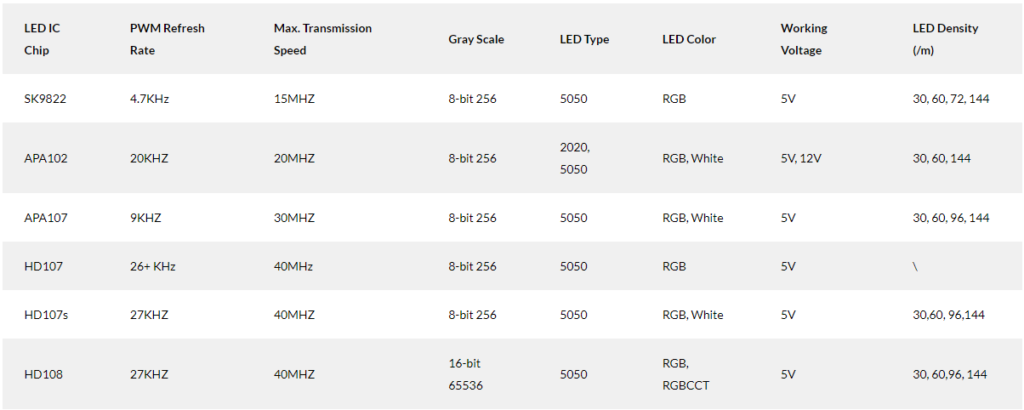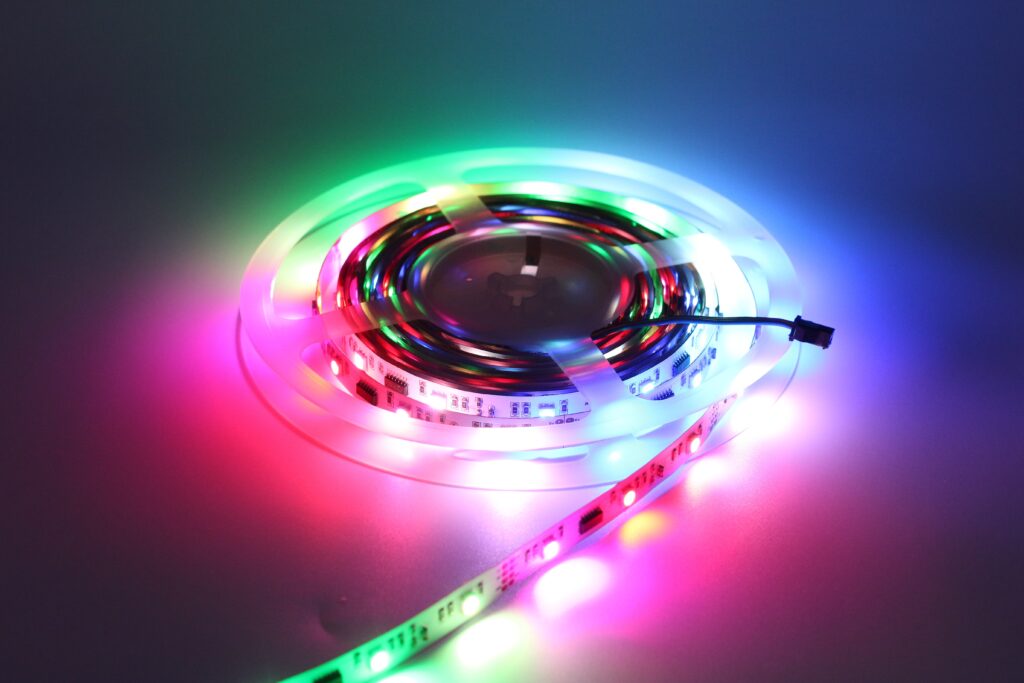SK9822, APA102, APA107, HD107, HD107s, and HD108 are all models of LED IC chips that are widely used in addressable LED strip applications. All of these chips use the transmission of data signals with clock signals to achieve lighting control. However, despite their similarity in working principles, they may have some important differences in some aspects. Now, let’s start exploring the differences among SK9822, APA102, APA107, HD107S and HD108.

SK9822, APA102, APA107, HD107, HD107S, and HD108 Overview
APA102: APA102 is a clone and upgrade of WS2812 LED, which was called “Super LED” . With a 5V working voltage, APA102 refresh rate can reach 19KHZ, transmission rate can reach 30mHZ. But from 2016, the original factory no longer produces APA102 LED chips. So now only the APA102 clone – APA102C exists in the market. But its refresh rate and transmission rate are far worse than APA102.

SK9822: SK9822 is similar to APA102, it is usually regarded as an improved version or clone of APA102, with similar functions and performance. SK9822 is a more cost-effective product. However, the parameters of SK9822 are much lower, the refresh rate is only 4.7KHz, and the transmission rate is only 15mHz, only enough for general applications. The operating voltage is 5V.
APA107: APA107 provides similar functionality to APA102, but it uses a slightly different communication protocol than APA102. APA107 introduces a controllable PWM pin for improved color control accuracy and is designed to be more compatible with some microcontrollers. The APA107 operates at 5V and has a PWM frequency of 9 KHz.
HD107 and HD107s: HD107 is similar to APA107, but with better color performance and higher overall quality. HD107S LED is a direct replacement for the Taiwan APA102 LED. HD107s takes some of the control features of APA102 LED chip and further enhances pin stability and the factory quality inspection process. They operate on 5V with a PWM frequency of 30 kHz.
HD108: The HD108 is an upgraded version of the HD107S, delivering improved color rendering and stability. Operates at 5V with a PWM frequency of up to 50 kHz. It is the newest chip in the HD series and offers enhanced functionality. HD108 shows the best animation and visual effects, and is ideal for LED screens and outdoor advertising displays that require high image quality and brightness control.

APA102 VS SK9822, which one is better?
SK9822 is compatible with APA102. A significant difference between APA102 and SK9822 is their PWM refresh rate. APA102 has a PWM frequency of 20kHz, while SK9822 operates at a lower frequency of 4.7kHz. This may affect the smoothness and quality of the color transition in some applications.
However, in terms of price, SK9822 is usually more affordable than APA102. The smaller chip size (0.65mm², APA102-1mm²) allows SK9822 to potentially save on costs.
Why choose HD107S instead of WS2812 or SK6812 LED?
Faster
HD107S support a varying data rate of up to 500,000 LED updates per second. WS2812 only supports a fixed 30,000 LED updates per second.
Higher PWM Rate
WS2812 uses 400Hz PWM signal for color display. HD107S uses 27KHz, resulting in a much smoother image, better low-light performance, and availability for POV (persistence of vision) displays.
More Versatility
HD107S includes a 32-level “brightness” value which increases the effective number of brightness levels from 256 to over 3,000 and improves fine brightness control at lower brightness levels.
Low Power Consumption
HD107s uses the latest in power-saving technology, offering a 25% reduction in power draw, and an automatic sleep mode offering up to 99% power reduction when the led is turned off.
HD107 VS HD107S VS HD108
With higher refresh rates and color consistency than HD107, HD107S and HD108 ensure smoother animation, more responsive lighting effects, and better color matching and uniformity across the entire LED strip or pixel matrix. Therefore, HD107S and HD108 are the top choices for projects that require superior performance and faster updates.
One special feature of HD107S is its ability to digitally control the current of the connected LEDs. This means that it is possible to control the LED brightness by varying the current, rather than the traditional control of varying the PWM signal. With 5-bit global current control, you can reduce the brightness of the HD107S LEDs as needed without sacrificing resolution (i.e., the number of gray levels).
In general, HD108 is slightly more expensive than HD107 and HD107S, because it with the fastest refresh rate, uses 16-bit 65536 high grayscale, and has a fuller range of colors. HD108 LED is an upgraded version of HD107S LED. In a nutshell, HD108 is arguably the best of these addressable IC chips.
Pixel LED chips with 16-bit (65536 levels) high grayscale on the market today:
- HD108: 27kHz PWM refresh rate, 40Mbps max transmission speed
- APA102-65536: 4KHz PWM refresh rate, 30Mbps max transmission speed
- SK9826: 4KHz PWM refresh rate, 30Mbps max transmission speed
Learn More About HD108
We talked about HD108 having a 16-bit 65536 high grayscale, so what’s the difference between a 16-bit HD108 LED and other pixel IC chips like the 8-bit APA102? We need to know that higher gray levels provide richer, more realistic and detailed images and animations.
16-bit HD108 VS 8-bit APA102
In an 8-bit LED lighting control system, there are 256 different gray levels, from 0 for pure black to 255 for pure white. Such a lighting system produces relatively smooth brightness transitions, but may have grainy brightness steps in darker areas.
With an appropriate addressable LED controller such as BC216, K-1000C, H801SB, H806SB, you can adjust the brightness of each color (red, green, blue) separately for the HD108 LED strip.
High Refresh Rate
HD108 is considered to be the fastest refreshing pixel LED. It responds and updates the LED status faster for a more instantaneous effect when the signal is transmitted to the LED strip.
Smaller Voltage Drop
Compared to APA102, HD108 has a lower voltage drop. HD108 has been designed with a lower forward voltage drop, so that HD108 LEDs can achieve a specified brightness level at lower voltages, resulting in a lower voltage drop across the LED strip light.
On the other hand, APA102 has a relatively high forward voltage drop. When operating at the same brightness level as the HD108, the higher voltage drop may result in an increased voltage drop across the APA102 LED strip. This is why long APA102 LED strip can fail.
On shorter APA102 led strips, the transmission delay of the clock signal is relatively small. Therefore, with faster clock speeds, short APA102 led strips are able to follow the clock signals well and achieve stable data transmission and lighting effects.
In contrast, long APA102 LED strips cause signal degradation. As the signal transmission distance on the long strip increases, the clock signal and data signal will gradually weaken, resulting in data transmission problems.
In Conclusion
In this blog, we provide a comprehensive comparison and introduction to the SK9822, APA102, APA107, HD107, HD107s, and HD108 addressable LED chips. By understanding their features and performance and then choosing the one that best fits your specific project requirements.


